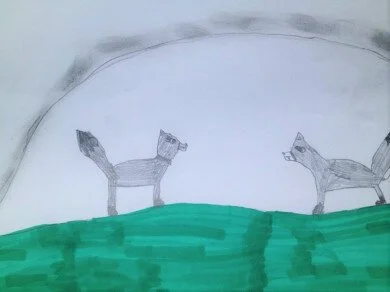Understanding Your Kids' Art
Last week I found a picture left behind by one of the children in our art studio. A scaled dragon with spikes on his tail roars and huffs out flames right at a little boy’s head. And what is the boy doing? He is holding up a marshmallow at the end of long stick. I find the mix of fun and fury so endearing. I suspect I might like to have this young artist around if I am ever ambushed by a dragon.
Remember the Rorschach test, those inky blobs that might accidentally expose your secret ambition to win American Idol? I remember in my early college days our teacher passing them around so we could share with our classmates what they made us think about. I remember being vaguely nervous, like they had some magic power. The very idea that incoherent black ink would reveal some unknown truth from a dark corner of my mind was, well, disturbing. Much later and deeper in my studies in mental health the inky blobs were demystified.
It turns out there’s really not much magic in them. They’re just inky blobs. What makes them special is that they are unformed enough to not be suggestive on their own. That, it turns out, is the power they possess. They have been proven to be sufficiently vague to allow you to fill in the gaps. Now, whether this gets at any dark secrets is another matter. It really depends on whether you have any (who doesn’t) and whether you want to tell them.
And that brings me to children’s drawings. The blank page and crayon is a bit like an inkblot test. A crayon and paper has the magical ability to make a child sit still awhile and perhaps become a bit reflective. As counselors we will sometimes ask children to draw their home with their family, or perhaps draw their family doing something together. When we do this, we aren’t looking for the hidden meaning of the marshmallow (that’s as silly as it sounds), we’re looking for patterns or repeated ideas. But mostly a good counselor is looking for a chance to listen to the art, because it is and excellent source of child communication.
Are you listening to your child’s art? As they tell you about the boy and girl fox on the hill, maybe you could ask, “What is that fox thinking?” They might tell you he is in love with the girl fox, because she has long eyelashes. And then you’ll know your ten-year-old is beginning to feel like a girl. And you can tell her that her eyelashes are as pretty as the foxes. Because that is likely what she was hoping.
They might just draw a happy garden of flowers with the standard sun in the corner. But that’s okay, because you can just ask them how they were feeling when they made that picture. And they might tell you they were so happy because this is the week daddy is coming. It only takes a moment to look quietly and ask a few kind and gentle questions.
My niece once drew a picture of herself at the top of a ladder in a loft. At the bottom of the ladder were her two older sisters, tiny and rather wild looking. In the next drawing she was holding her mom and dad’s hands, smiling from ear to ear. Her sisters were far, far away, in the corner of the drawing. Patterns. My poor little niece was feeling unloved, annoyed, and left out. And she needed someone to create the kind of space where, for just one moment, she could express it.
Are you listening to your child’s art? Are you creating an environment where your child can be heard? Because if you look with your eyes and hear with your heart, you will catch all the best parts.

